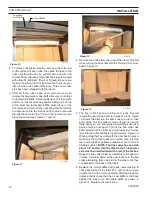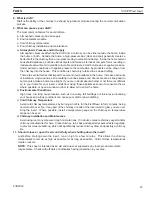
SSI30 Wood Insert
63D4004
9
ChIMNEY ClEARANCES
ChIMNEY
Refer to chimney and chimney connector manufacturer’s
instructions.
Contact your local building authority for approved methods
of installation
1. This appliance requires a masonry or pre-manufactured
chimney listed to ULCS629 (Canada) and UL 103 HT
(USA) sized correctly.
2. If a masonry chimney is used it is advisable to have your
chimney inspected for cracks and check the general
condition before you install your unit. Re-lining may
be required to reduce flue diameter to the appropriate
functional size.
3. The chimney should extend at least 3' (914 mm) above
the highest point where it passes through the roof, and
at least 2' (610 mm) higher than any portion of a building
within 10' (3 m).
Figure 5
4. The chimney connector shall not pass through an attic,
roof space, closet, concealed space, floor, ceiling, wall
or any partition of combustible construction.
5. The minimum overall height of your chimney should be
15' (5 m) from the floor.
6. Do not use makeshift compromises during
installation.
0 to 10’
2’ Min.
3’ Min.
0 to 10’
2’ Min.
3’ Min.
ST1012
2 3 10 rule
Reference Point
ST1012
Figure 5 -
The 2'-3'-10' Chimney Rule
At the very least, inspect the chimney connector and
chimney at least once every two months during the heating
season to determine if a buildup of creosote or soot has
occurred. If a significant layer of creosote has accumulated
(1/8" (3 mm) or more], or if soot has accumulated, either
should be removed to reduce the risk of a chimney fire.
Failure to keep the chimney and connector system clean
can result in a serious chimney fire.
The conditions for a chimney fire develop as follows: When
wood is burned slowly, it produces tar and other organic
vapors which combine with expelled moisture to form
creosote. The creosote vapors condense in the relatively
cool chimney flue of a slow burning fire. As a result
creosote residue accumulates on the flue lining. Creosote
is a flammable and, when ignited, make an extremely hot
fire within the flue system which can damage the chimney
and overheat adjacent combustible material.
To reduce the amount of creosote that may form, remember
to provide adequate air for combustion and to strive for
small, intense fires rather than large smoldering ones.
You can never be too safe. Contact your local fire authority
for information on what to do in the event of a chimney
fire, and have a clearly understood plan on how to handle
one.
NOTES ON ChIMNEY ANd INSERTpIpE INSu-
lATION:
Maintaining a clean chimney is important. Chimneys should
be inspected regularly for creosote buildup. A straight
chimney is easier to clean than one with 45 or 90 degree
bends. A bend requires the pipe to be removed for cleaning.
The insert baffle must be removed when cleaning the
chimney.
Page 18.
Chimney sweepings will build up on top
of baffle causing a blocked flue and/or a fire hazard.
Steel Chimney
Most factory made “Class A” steel chimneys have a layer
of insulation around the inner flue. This insulation keeps
the smoke warm and protects the surrounding structure
from the high flue temperatures. Because the insulation is
less dense than masonry, the inner steel liner warms up
more quickly than masonry chimney; this makes the steel
chimney support a good draft more quickly than masonry
does.
Indoor/Outdoor location
Because the chimney’s function is to keep the smoke
warm, it is best to locate it inside the house. This location
uses the house as insulation for the flue and allows some
radiant heat release form the flue into the home. Since an
interior chimney doesn’t continuously lose its heat to the
outdoors, less heat from the insert is required to get it warm
and keep it warm.
Flue Sizing
The flue size for a controlled-combustion appliance should
be based on the cross-sectional volume of the insert flue
outlet. In this case, more is definitely not better. Hot gases
lose heat through expansion; if a insert with a six-inch flue
collar (28 square inch area) is vented into a 10" x 10" flue,
the gases will expand to over three times their original
volume. As gases cool with expansion, draft strength
decreases. If the oversized flue is also outside the house,
the heat it absorbs will be conducted to the outdoor air and
the flue will remain relatively cool.










































